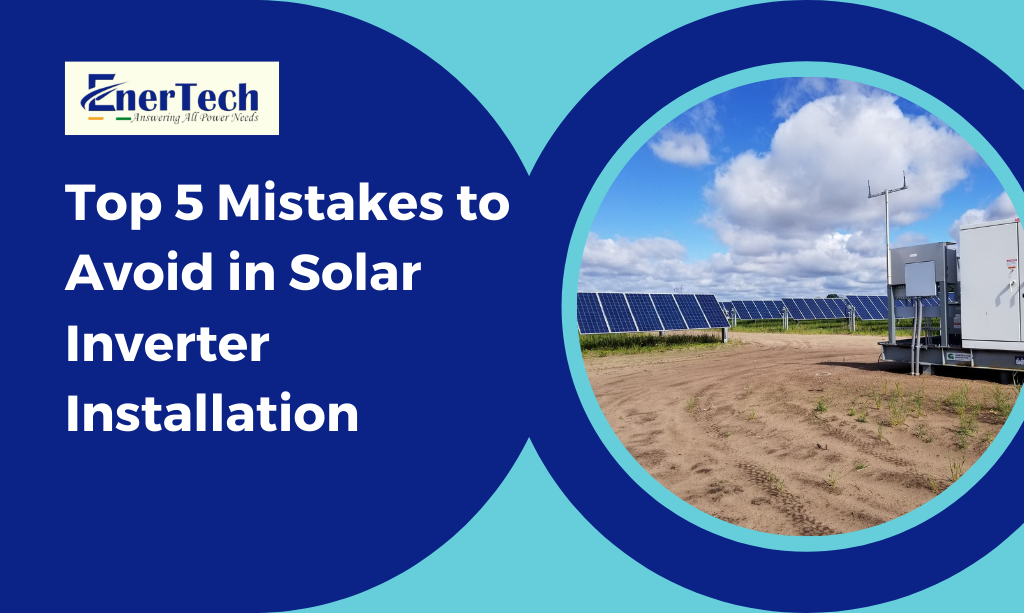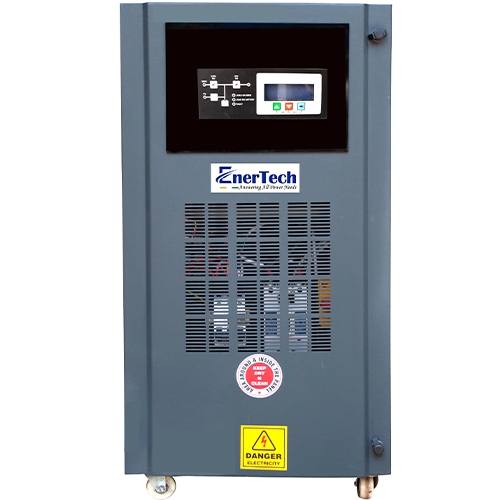Are you looking to install a solar inverter in your solar energy setup? We congratulate the visionary decision to enhance your use of solar energy. However, you must complement your decision with the right solar inverter installation so that you make the most of it. Thus, we’d like to acquaint you with a few common mistakes people commit while installing solar inverters. It will help you avoid them and ensure correct and effective solar inverter installation.
What is a Solar Inverter?
Most of you who have decided to install a solar inverter would already know what the inverter is all about. However, for those new to this space, here’s the basic idea. A solar inverter converts direct current (DC) electricity that the solar panels capture into alternate current (AC) to power domestic appliances and devices.
Fundamentally, solar inverters channel DC electricity via a transformer that lowers the voltage and changes it to AC. The DC runs via two or more transistors. The system rapidly turns the transistors on and off to feed the transformer’s two different sides. So, now that you’ve got a basic understanding of what a solar inverter is, let’s look at the common mistakes to avoid while installing one.
What Not to Do During Solar Inverter Installation – 5 Mistakes to Avoid
The key to effective installation is considering all the required elements and ensuring safe, effective, and appropriate installation. So, here’s what you shouldn’t do while installing a solar inverter.
1. Not Using the Solar Inverter Installation Manual
Installation manuals are painstakingly created to help you use a particular appliance or device correctly and safely. Solar inverter installation manuals aren’t an exception. However, often, we see people ignoring or neglecting what the manual says.
Experts compile manuals and guide you comprehensively through the installation process to avoid mistakes. Hence, while installing a solar inverter, you should go through the manual and consult the company’s expert if you don’t understand a particular point.
2. Placing the Solar Inverter in an Incorrect Place
Another mistake people commit while installing the inverter is choosing the wrong location. Here, incorrect location refers to a place with inadequate ventilation or exposure to harsh weather conditions.
Now, why is the location so important? Inverters generate heat and require proper ventilation to operate efficiently. Placing it in the wrong place can result in performance deterioration, overheating, and a shorter lifespan.
So now, how do you choose the right place? Placing it indoors in weatherproof enclosures with enough shade and ventilation is ideal. However, if you cannot do it indoors, select a place where the inverter wouldn’t come in direct contact with sunlight and extreme temperatures.
3. Ignoring System Grounding
Often, people fail to properly ground the solar system and inverter. Remember, appropriate grounding is vital for safety and preventing electrical shocks. Also, it plays a vital role in protecting equipment from electrical surges and lightning strikes.
Thus, you should ensure your system is properly grounded per the local codes and guidelines. Additionally, you should use the right grounding conductors and bonding methods as one of the safety measures for solar inverter installation.
4. Insufficient Wiring and Connections
Using undersized wires or poor-quality connections that aren’t rated for the inverter’s current and voltage is another common mistake. Such inadequate wiring can lead to voltage drops, fire hazards, and overheating. Besides, it can impact the safety and efficiency of the system.
Accordingly, you must choose appropriately sized and rated cables. Also, you must ensure all your connections are secure and compliant with electrical codes and standards.
5. Neglecting the Importance of DC Connectors
DC connectors and their correct connection play a vital role in solar energy system setups. Solar inverter manufacturers provide spare PV connectors. Even then, many people indulge in cross mating (using connectors of different types or brands).
Such a practice can result in DC arching and in worse cases, fire incidents. Hence, avoiding cross mating and using the spare connectors of the inverter company is the right practice.
More Mistakes to Avoid During Solar Inverter Installations
• Underestimating Energy Needs: You must accurately assess your current and future energy needs so that you install a solar system that meets all power requirements effectively and efficiently.
• Improper Sizing: You must ensure your inverter’s size is appropriate for the load requirements and solar panel capacity to prevent problems like inefficiency and system breakdown or failure.
• Lack of Battery Compatibility: The inverter should be compatible with the batteries used (Lithium, Lead-acid) for efficient energy storage and usage.
• Ignore Component Quality: While installing a solar inverter, you must also ensure the use of high-quality and reliable components to avoid premature system failure and increased maintenance costs in the long run.
• Inadequate Monitoring Setup: In addition, you must establish monitoring systems correctly for real-time and accurate performance tracking, identifying issues proactively and early, and ensuring optimal operation.
• Neglecting Local Regulations: Local rules and regulations are in place for a reason. Safety is one of the most critical. Accordingly, you must comply with all local building codes and regulations to ensure safe installation and prevent legal implications and actions.
• Poor Maintenance Planning and Scheduling: Solar inverters require maintenance just like every other equipment. Hence, you should prepare and adhere to a regular maintenance schedule so that the system performs optimally.
• Inadequate Load Assessment: A comprehensive load assessment helps avoid overloading the inverter and ensure it handles peak loads efficiently.
• Incorrect Grid Connection: Ensuring a proper and secure connection to the grid enables seamless operations and utility compliance.
• Overlooking Inverter Safety: You must install surge protectors and circuit breakers to secure the inverter from electrical surges and faults.
• Failing to Update Firmware: Updating the inverter’s firmware lets you leverage its latest features and updates. Thus, updating firmware regularly should form part of the solar inverter installation process.
• Not Testing System Performance: Testing the system thoroughly is essential for ensuring the correct and efficient functioning of all components.
• Insufficient Battery Ventilation: Battery should receive adequate ventilation to avoid overheating and gas build-up.
• Not Planning for Scaling: Power needs evolve with time. Hence, you should also plan for potential future expansion. An inverter that can handle additional solar panels or extra battery capacity can prove crucial.
• Inappropriate Mounting: The inverter should be mounted securely to avoid vibration and physical damage that can affect functionality.
• Inaccurate System Design: Work your inverter size out per your needs and site conditions with a qualified system designer.
Final Words of Solar Inverter Installation
So, that was about the five common mistakes people commit while doing solar inverter installation. We hope the above helps. However, we recommend getting solar inverters installed by experts to save the hassles and stay safe.
EnerTech, one of leading solar inverter manufacturer in India, can serve the purpose. While manufacturing solar inverters, our support extends to providing comprehensive customer support, including installation, technical troubleshooting, and maintenance.
Please email us at sales@enertechups.com to learn more about our solar inverter products.
Tags: solar inverter, solar inverter manufacturer in india, 3 phase solar inverter, off grid solar inverters, best solar inverter in india, solar inverter supplier in india, best hybrid solar inverter in india, hybrid solar inverter, solar hybrid inverter manufacturers in india





